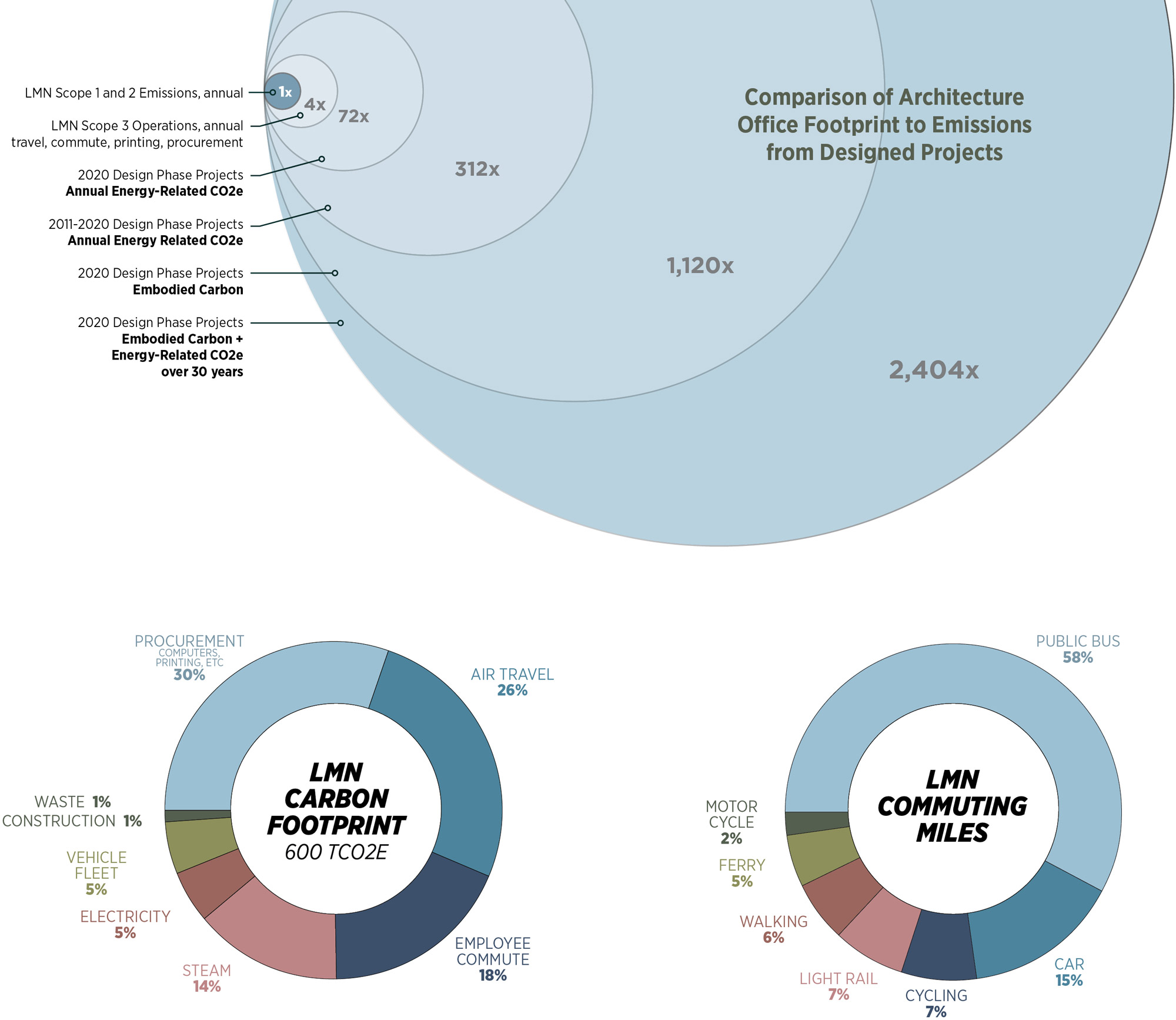#actionplan, #sustainability
2024 Sustainability Action Plan
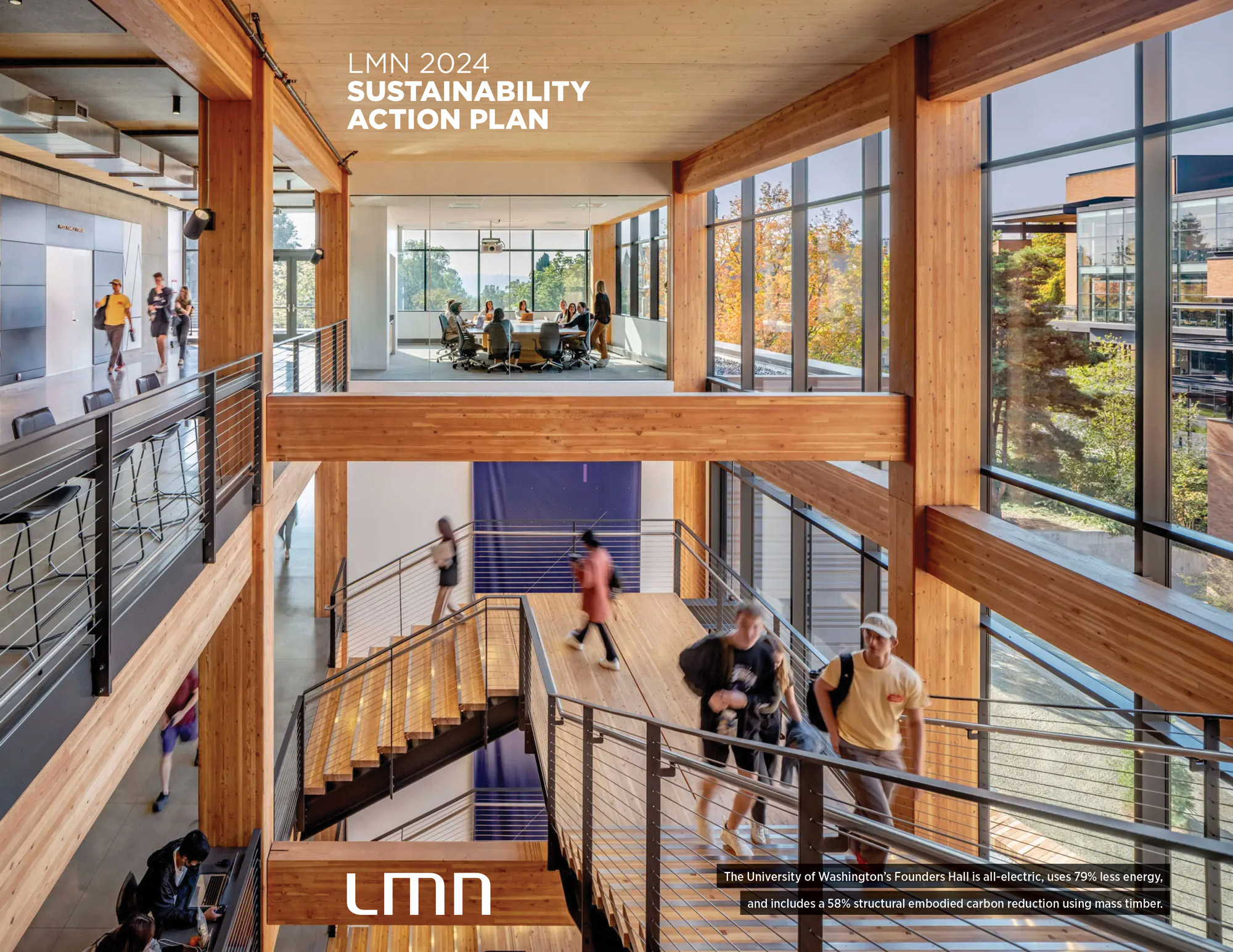
This update to our Sustainability Action Plan advances our commitments to a just and sustainable world. Urgent and collaborative action is needed to continue advancing climate action, environmental justice, and health issues. The design of our built environment is a critical part of each of these issues.
Download the LMN 2024 Sustainability Action Plan PDF
We believe
- Design has the power to transform our interactions and foster healthy, livable communities and an equitable society.
- Humane and inviting urban spaces help to preserve wild and natural areas.
- Research and innovation is integral to the practice of architecture.
We actively
- Help our clients realize their sustainability aspirations through a holistic, collaborative design process.
- Combine the hard data of performance modeling with the inspirational qualities that improve human health.
- Advocate for policies that align with our values including reduced carbon emissions and water use, materials transparency, equity and resilience.
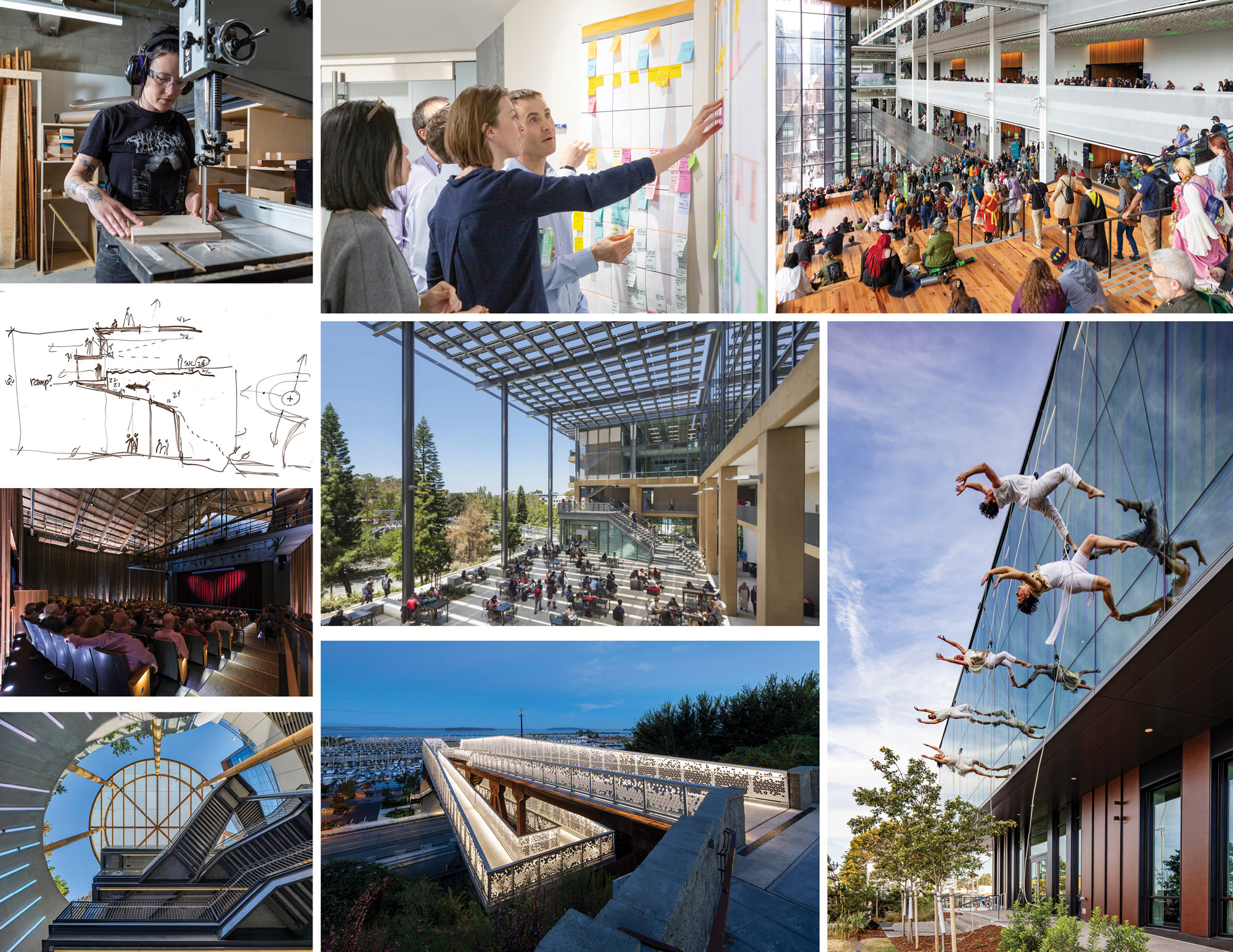
There are no carbon neutral buildings… yet
Our industry is in the midst of a radical energy transition to eliminate the effects of air and water pollution from combustion, climate destabilization, and issues of equity within the built environment. As one of the leaders in sustainable design and innovation, our clients are increasingly looking to LMN to provide collaborative research and guidance to set, meet and exceed their own goals.
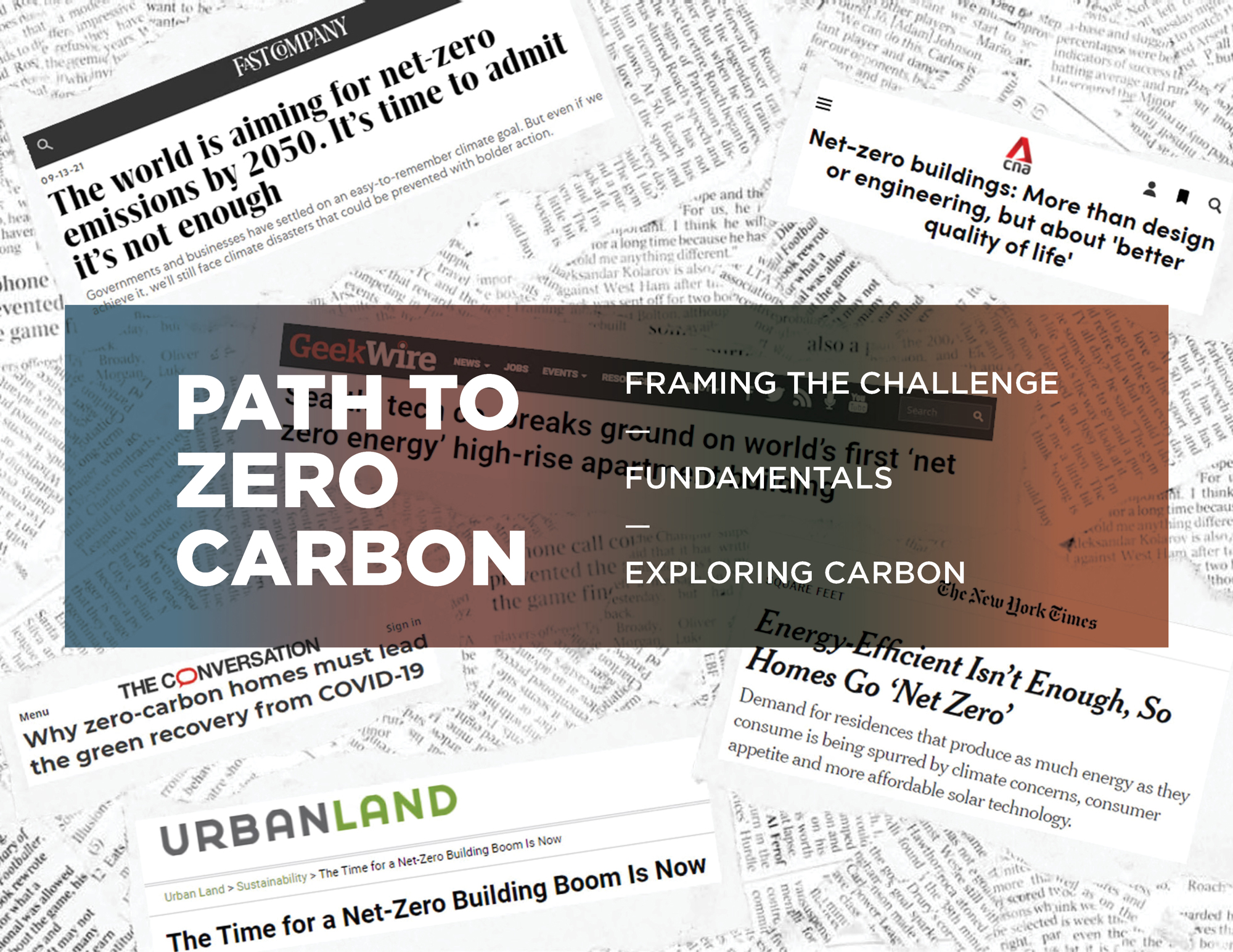
LMN’s Path To Zero Carbon series is an exploration of how our profession and allies can reach a carbon neutral built environment. It includes carbon pollution from nearly all sources, as well as methods and tools to analyze and reduce emissions across all sectors.

The 16 topics researched for the Path To Zero Carbon series.
The series engages many experts outside LMN, aiming for an industry standard resource to understand the transition towards addressing carbon pollution directly and comprehensively in the built environment.
No modern carbon neutral buildings exist…yet. Until we have construction products, energy and storage, a circular economy, and construction methods that are each carbon neutral (without offsets), any claims of carbon neutrality or net zero carbon are inaccurate. Headlines that prematurely claim carbon neutrality are detrimental to the real and incremental progress being made.
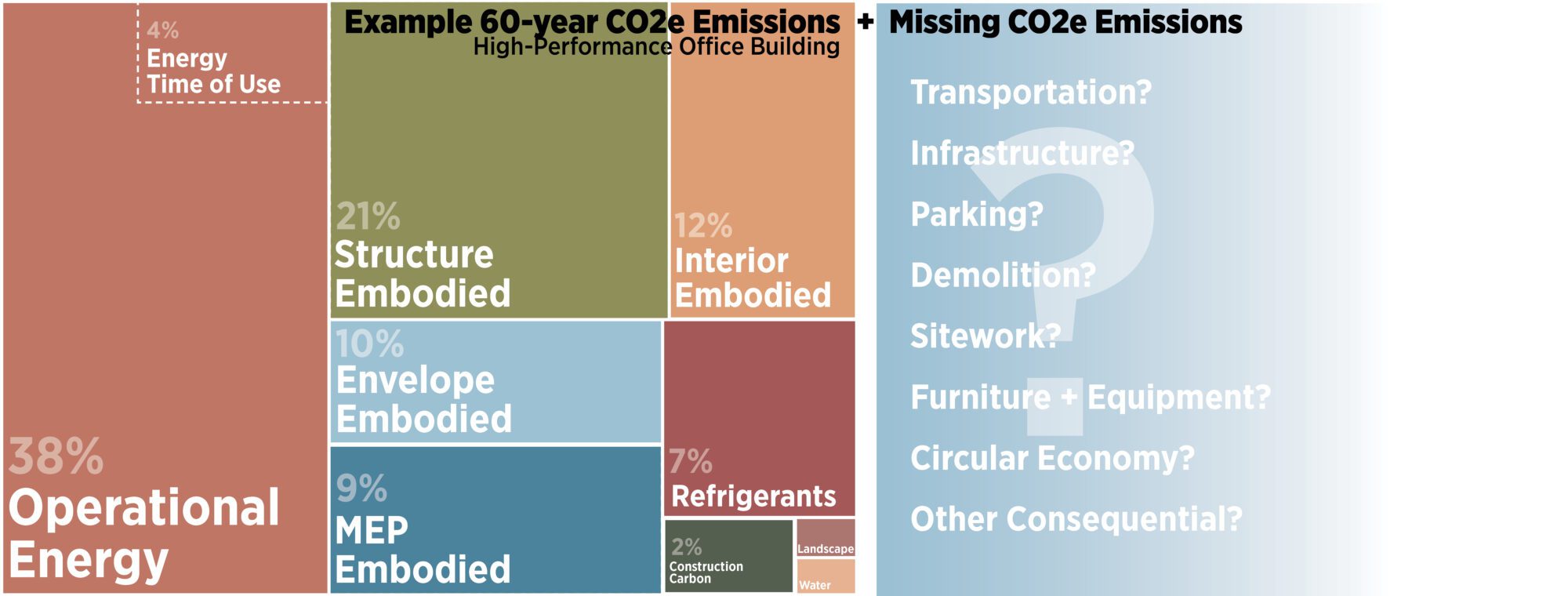
A more comprehensive carbon analysis for one building, looking at operational energy use and many areas of embodied carbon. This tree chart excludes consequential emissions such as transportation, land use, and infrastructural embodied carbon, though those are covered in the series.
Design + Approach
This Action Plan includes methods to expand the culture of cutting edge sustainable design at LMN. It includes commitments to firm and project processes for all projects and areas, where we will pilot new sustainable design products and techniques over the next 3 years. More detail on these areas follows this section.
Firm Culture
- Identify consultant partners that drive us toward our sustainability goals, including active members of MEP 2040, SE 2050, CLF, and other collaborative, leading organizations.
- Staff on-boarding meetings on sustainability goals, with one-pager
- Project design reviews include sustainability metrics
- Applied Research Teams form each year to address emerging areas
- Regular topical meetings (PA, PM, CA, EP) include sustainability discussions
Processes for Every Project
- Assign a Project Sustainability Coordinator
- Early phase client workshops on sustainability, including Carbon, Equity, and Wellness
- Set reasonable, quantifiable goals on energy and carbon. Identify barriers and address them.
- Early energy and embodied carbon analysis and reductions.
- Begin projects with reasonable glazing area.
- Sustainability diagram reflects goals
- Sustainability process checklist and narrative
Pilot Areas
- Identify projects to use innovative, low-carbon and biogenic materials
Overall Goals
- Continue AIA 2030 Reporting, improving from 85% fossil fuel energy use reduction to 100% by 2030.
- Advance our understanding and specification of materials that support living wage jobs.
- Track and reduce comprehensive embodied carbon on all projects, striving to meet Science Based Targets Initiative embodied carbon goals
- Advance our understanding and specification of materials with fewer or no toxins.
- Engage with the circular economy in design, reuse, and demolition.

Operational Energy + Carbon
Climate destabilization is one of the defining challenges of our time, and our industry is responsible for roughly 40% of global CO2e pollution.
While LMN averages a 85% operational energy use reduction per the 2030 Challenge, we are only roughly 10% of the way towards embodied carbon neutral buildings across our portfolio. The Path to Zero Carbon series outlines our efforts to understand and change the way we and our industry practices so we can limit climate destabilization and warming.
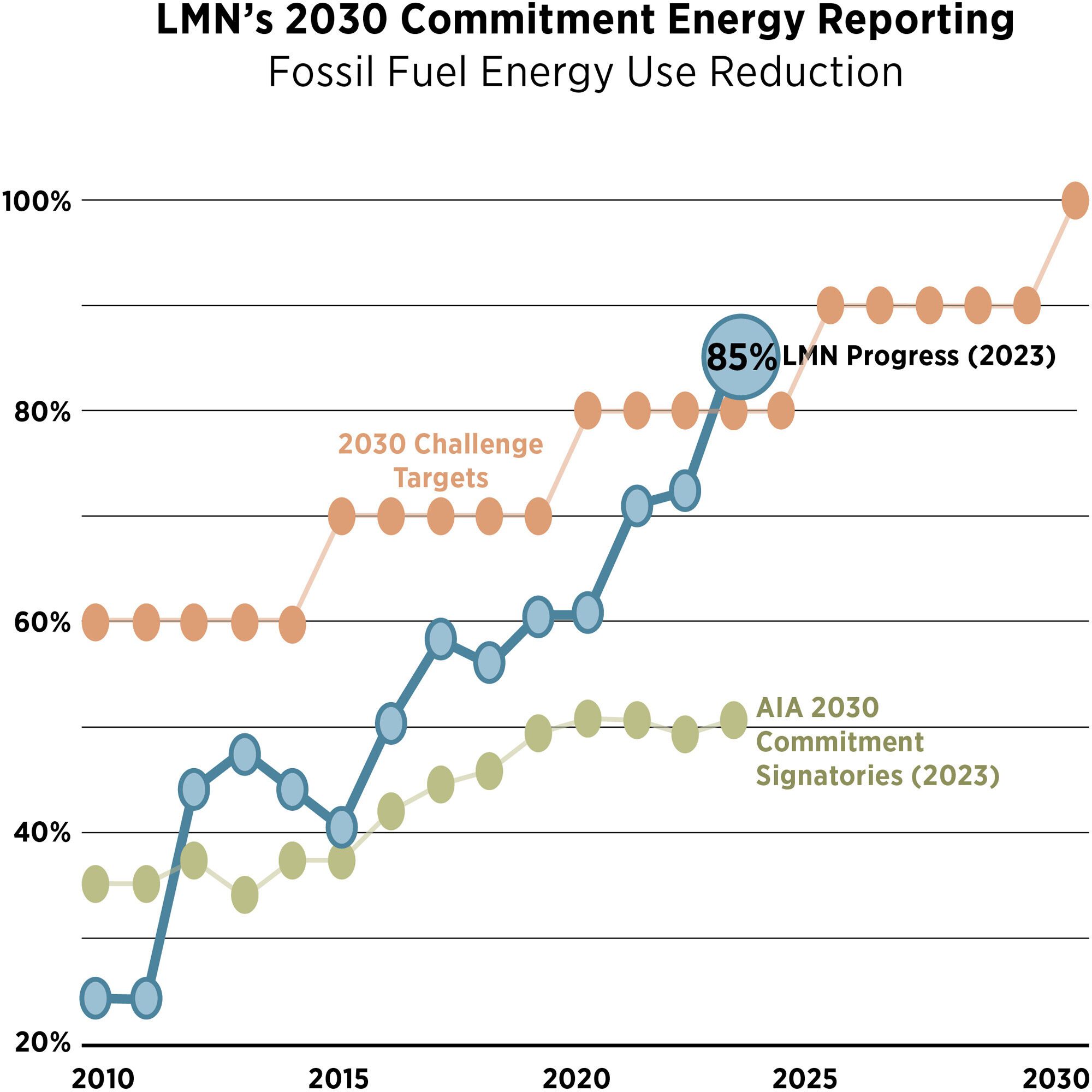
Firm Processes
- Support Applied Research Teams for Carbon Tools, Circular Economy, and other improvement areas.
- Work with consultants aligned with SE 2050 and MEP 2040 goals
- Continue LMN Carbon Footprinting, review offset quality
- See Materials section for Embodied Carbon
Processes for Every Project
- Concept-level internal workshop on sustainability
- Early and late-phase energy modeling, including hourly and future electricity CO2e projections
- Early and late-phase embodied carbon modeling
- Begin with reasonable window to wall ratio
- Use carbon decision process timeline, comprehensive carbon analysis to compare envelope, MEP, operational, and consequential carbon.
- Review Specifications for low-carbon materials
- See Materials section
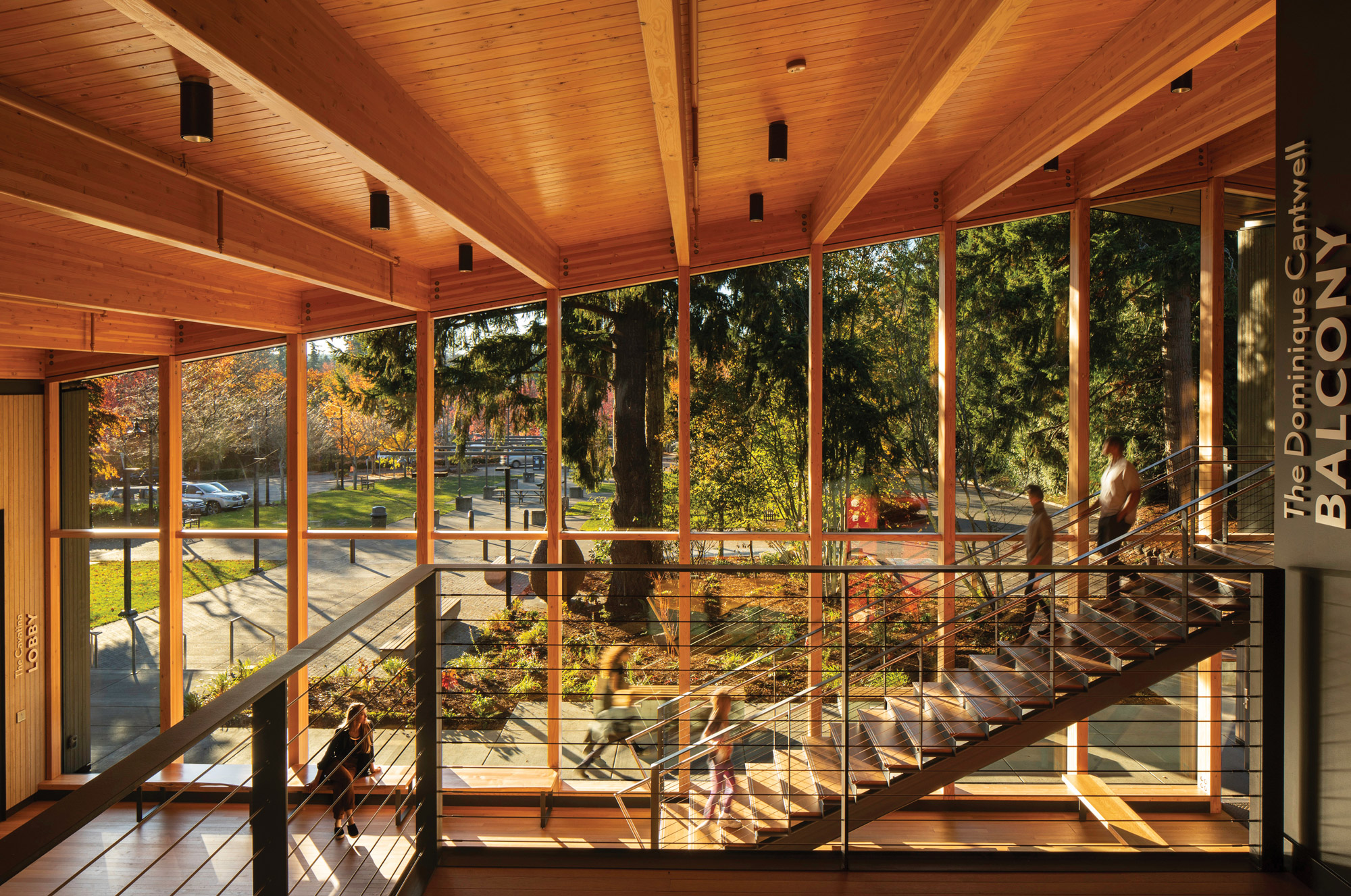
The Buxton Performing Arts Center is an all-electric renovation of existing performance and support spaces plus a new entrance and black box theater, with rooftop PV leading to a 73% energy use reduction . LEED Gold.

Four LMN buildings totaling over 800,000 sf for a technology company are all-electric and on track for ILFI Zero Carbon and LEED Platinum certifications, meeting the 2030 Challenge.
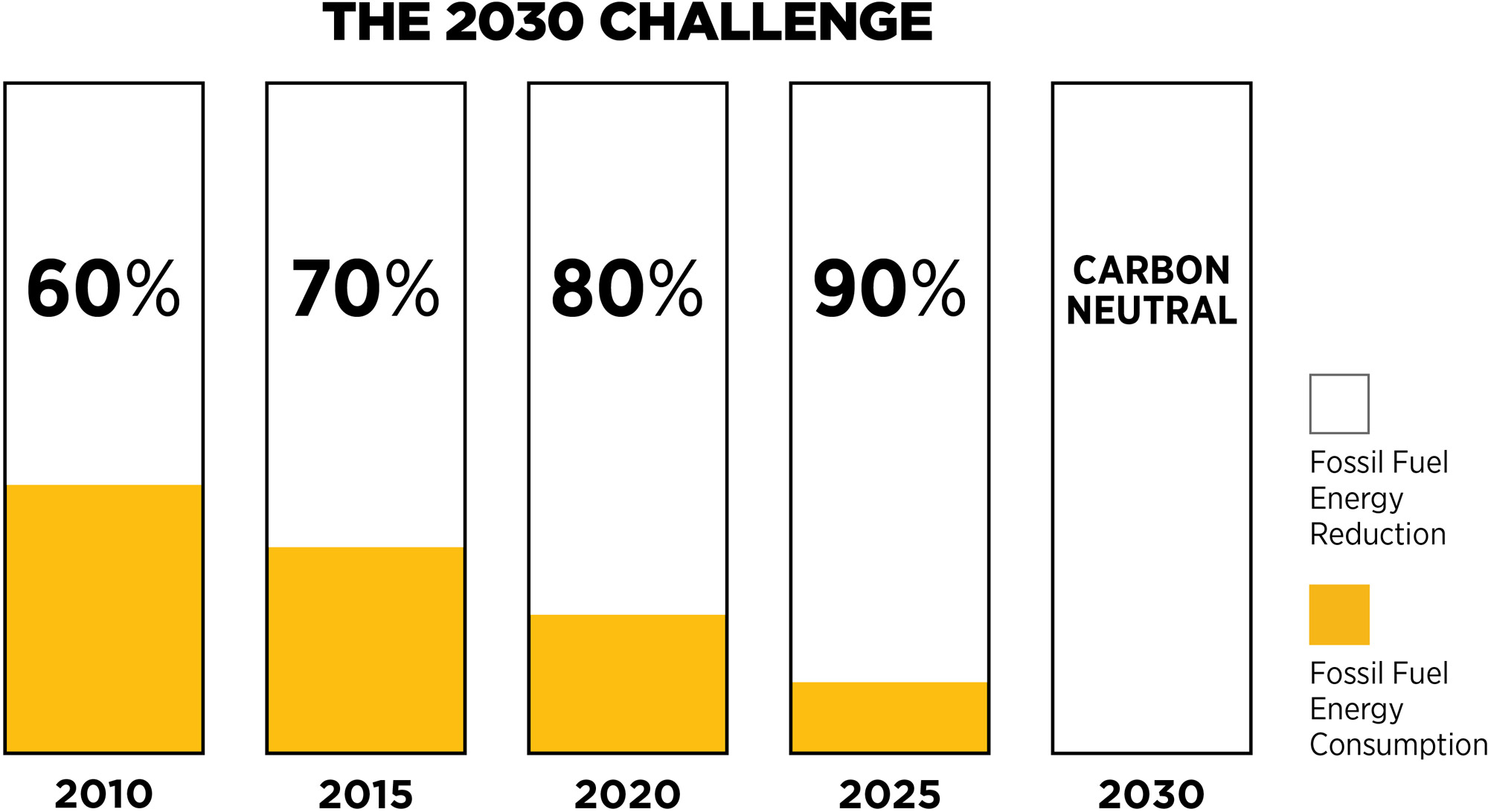
The 2030 Challenge sets increasingly stringent goals to reach carbon neutral, fossil fuel free new buildings by the year 2030 (left). LMN is a signatory of AIA’s version, the 2030 Commitment, for which we report average annual energy savings each year for our designs.
Metrics
- Design only operationally carbon neutral buildings by 2030 or before, improving from 85% fossil fuel energy use reduction to 100%.
- Meet Science Based Targets Initiative embodied carbon goals over time.
Pilot Areas
- Use hourly and future CO2e projections for electricity.
- Engage deeply in Circular Economy and Design for Deconstruction
- Comprehensive CO2e analysis for early decision-making, with both attributional and consequential sources.
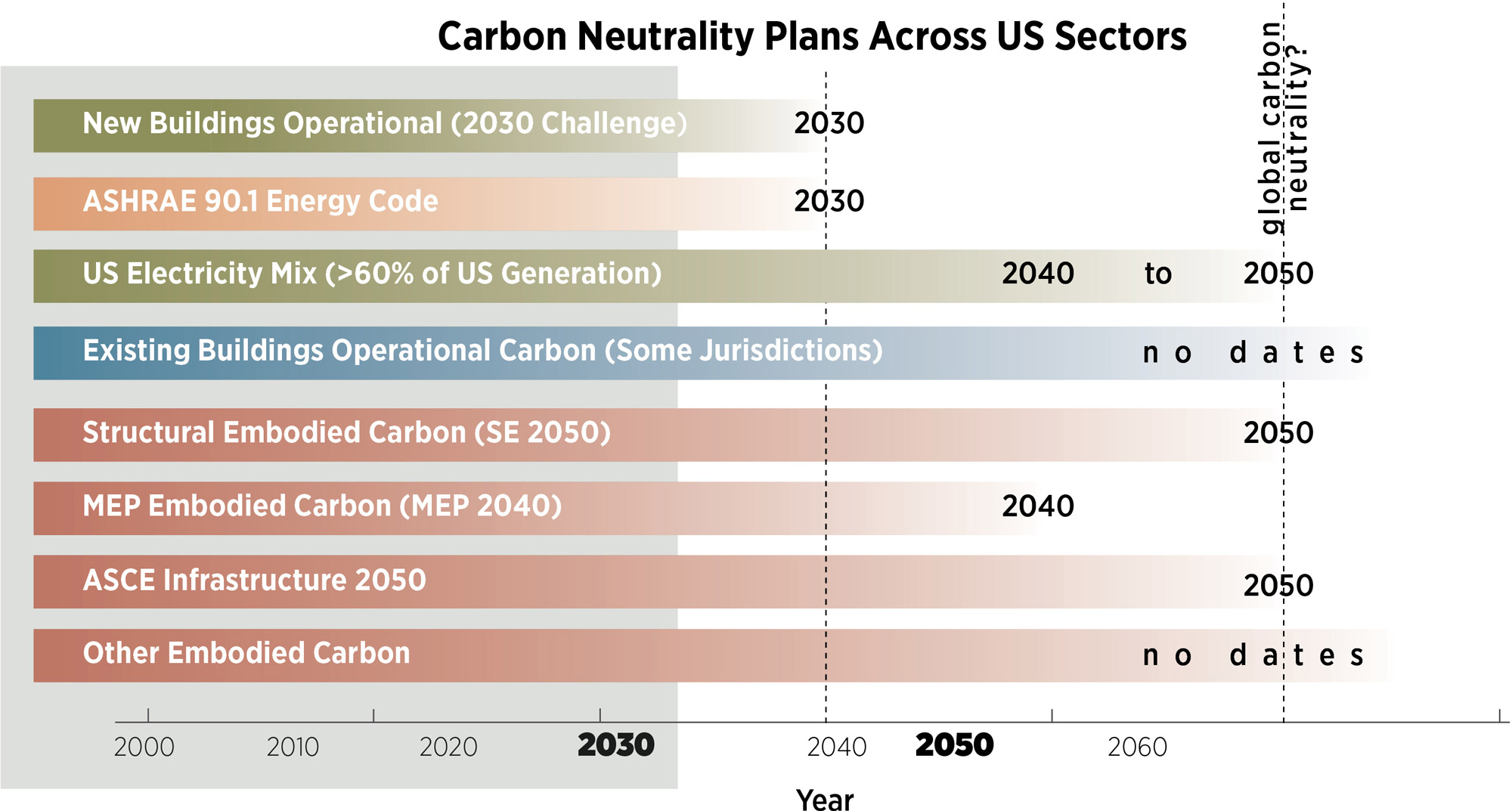

The Undergraduate Academic Building, UC Berkeley, under construction, will be an all-electric, mass timber building with naturally ventilated offices, meeting the 2030 Challenge.
Materials Selection + Embodied Carbon
Every piece of our designs includes a construction material, and each of these has an impact on our planet, our society, and our indoor environments. With hundreds of materials selected on each project based on dozens of criteria, no single goal overrides all others. Materials selection criteria are complicated and this plan addresses the largest impact materials so we can improve outcomes and move the market towards a carbon neutral, circular economy with minimal negative environmental impacts.
Firm Processes
- Establish clearer product-specific criteria for materials selection based on carbon, wellness, and equity.
- Materials Applied Research Team to Identify top materials for research and action (below)
- Coordinate among AIA Materials Pledge, Common Materials Framework, and Climate Toolkit for Interior Design
- Develop circular demolition specifications
Processes for Every Project
- Track LMN sustainability materials criteria within Technom
- Sustainable materials kickoff for all team members at DD and CD
- Designs includes at least 2 salvaged materials
Metrics
- Identify top products per areas below and find preferable substitutes.
Pilot Areas
- Identify projects for innovative and biogenic materials
- Engage with LMN Shop for materials testing for innovative materials.
- Identify projects to advance sustainable performance specs for low embodied carbon
- Material passports transferred to building owner convey deconstruction opportunities for product end of use
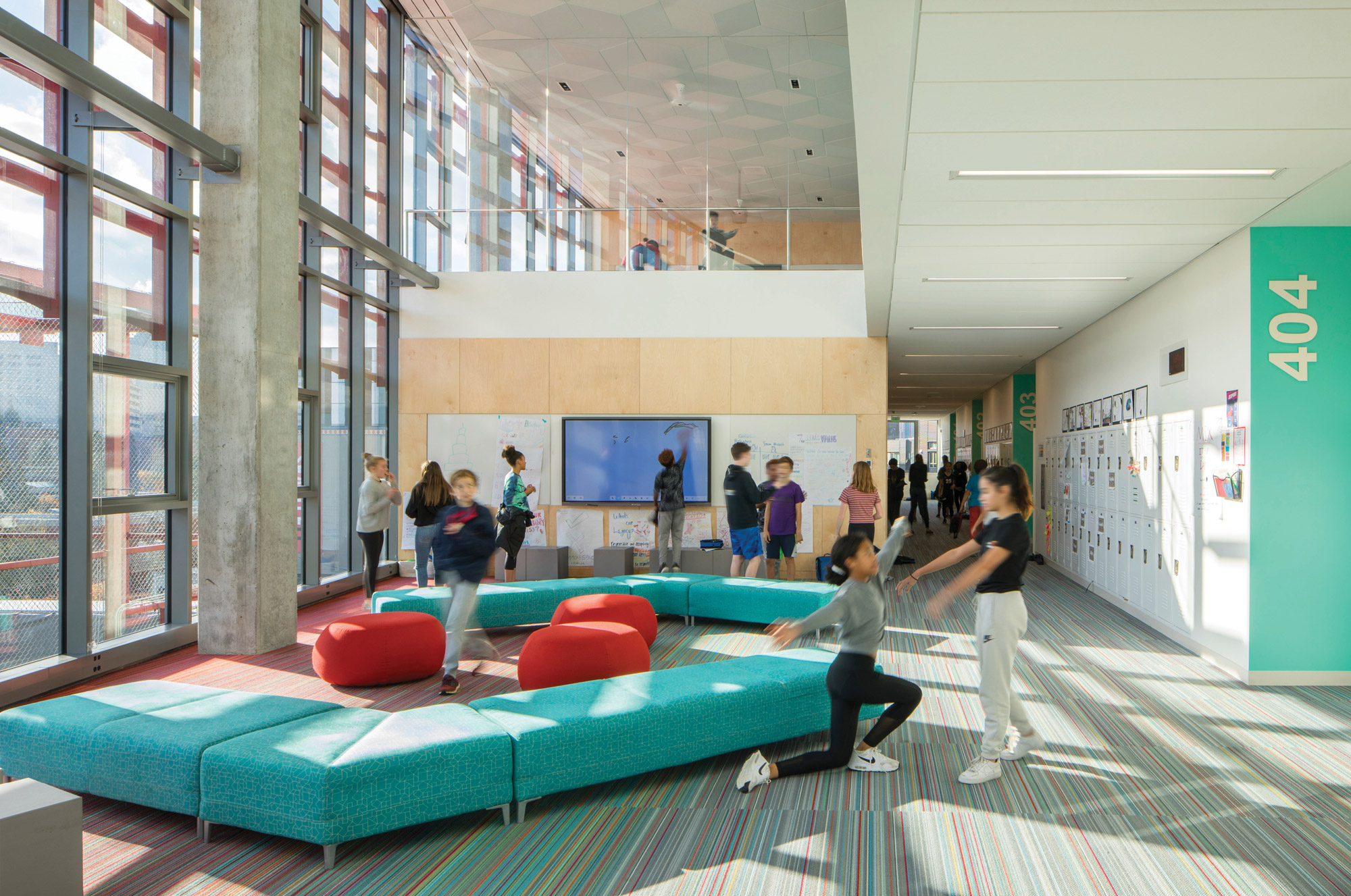
The Seattle Academy of Arts and Sciences Middle School found alternatives to vinyl, including for piping, to promote healthy indoor spaces and workplaces for those who manufacture products.
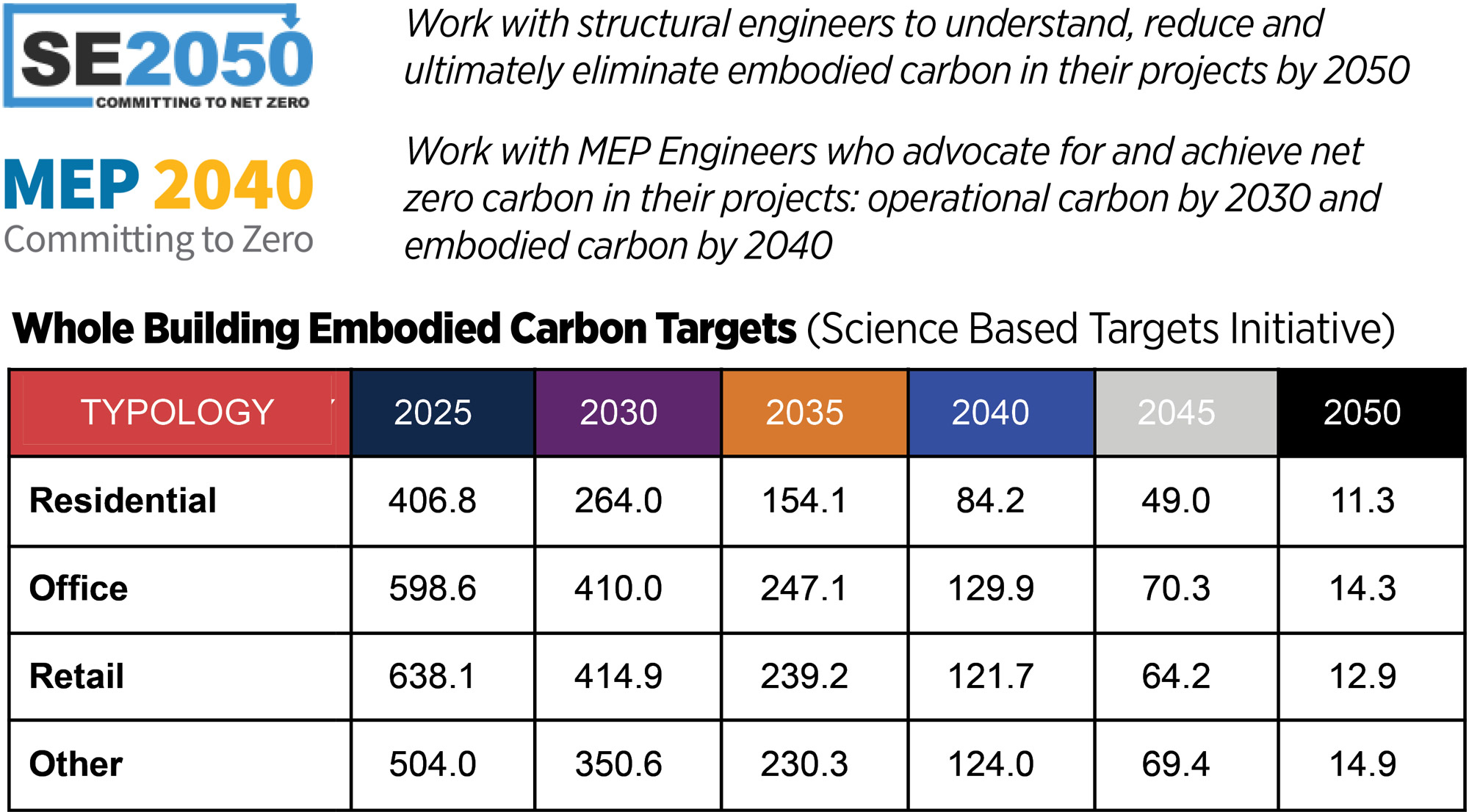
The Science Based Targets Initiative’s Embodied Carbon Pathways document contains goals for embodied carbon reductions based on typology. LMN is meeting this on an average annual basis.
Top 15 Materials: Embodied Carbon
These 15 materials account for roughly 60% of the total embodied carbon on our projects; we will use performance specifications for these materials:
- Structural Steel
- Concrete
- Mass Timber
- Rebar
- Metal Deck
- Fireproofing
- Insulation
- Glazing
- Mullions
- Cladding Materials
- Carpet
- Drywall
- Metal Studs
- Acoustic Ceilings
- Furniture – Workstations
Top 10 materials for chemicals of concern
Specify preferred alternatives to avoid chemicals of concern. Expand list to 30 materials in 2026
- Wall coverings and graphics (no vinyl)
- Textiles, refrigerants, carpets (no PFAS)
- Paints (limit microplastics)
- Metal Coatings (multiple criteria)
- Furniture (avoid flame retardants)
- Casework and finishes (low-VOC)
- Countertops (avoid particulates)
- Resilient flooring (avoid vinyl/PVC/LVT)
- Adhesives (multiple criteria)
- Composite Wood (avoid formaldehyde/polyurethane/VOCs in adhesives)
Refine Top 10 Materials: Equity and Supply Chain
Use Cradle to Cradle, FACTS, Living Product Challenge, Design for Freedom Framework to identify and avoid equity and supply chain injustice. Expand to 30 in 2026.
- Textiles (labor practices)
- Engineered stone (avoid unhealthy manufacturing and installation)
- PVC/Vinyl (avoid due to toxins from manufacturing and disposal)
- Paint (limit microplastics)
- Plastics, some insulation (limit fossil fuel-based products)
- Wood (avoid coerced labor, deforestation)
Refine top 10 materials: circularity
Identify sources for salvaged materials to incorporate on each product to reduce embodied carbon and create refurbishment market. Expand to 30 products in 2026.
- Doors
- Casework
- Furniture – Workstations
- Carpet – Transparent take-back program
- Bricks
- Concrete
- Wall panels
- Ceilings
- Insulation
- Equipment
Identify Top 10 Materials: Ecosystem Health
Develop strategies for action in 2026.

LMN’s remodel for Hines Seattle headquarters deeply engaged the circular economy, reducing embodied carbon by 65% whereas buying only new materials would have achieved only a 22% reduction. The team exported un-needed materials such as acoustic insulation and ceiling tiles, designed to reuse many materials in place, and imported many materials that were otherwise destined for the landfill or incineration, such as wood offcuts from a local manufacturer and carpet tiles.
Ecology + Water
Ecological functions that support human life are worth trillions of dollars each year and these systems are often degraded through site design and construction product environmental impacts. Restorative design uses freshwater appropriately, uses natural systems for site water management, and includes construction materials that are produced using ecologically healing practices.
Firm Processes
- Continue to develop LMN Water Reuse calculator
Processes for Every Project
- Engage Landscape and Civil on project site ecological functions, beyond codes. Assess water scarcity/watershed issues based on project and region
- Use LMN Water Reuse calculator on projects over 50,000 sf
- Narrative to address Framework for Design Excellence Water + Ecology questions
Metrics
- Achieve at least 6 LEED points for Indoor/Outdoor Water Use (v4)
Pilot Areas
- Design one project with vacuum or composting toilets
Project Options
Choose 2 Small < 50k sf, 4 Medium, 6 Large > 200k sf
- Study multi-block/campus-scale approaches for storm water and water
- Use LMN Water Reuse Calculator
- Study vacuum flush/ composting toilets
- Study 1.1 gpf toilets
- Incorporate Salmon Safe principles for water quality
- Incorporate Salmon Safe principles for exterior materials
- Incorporate Seattle storm water code
- Reduce Eutrophication and Acidification by 20% based on WBLCA
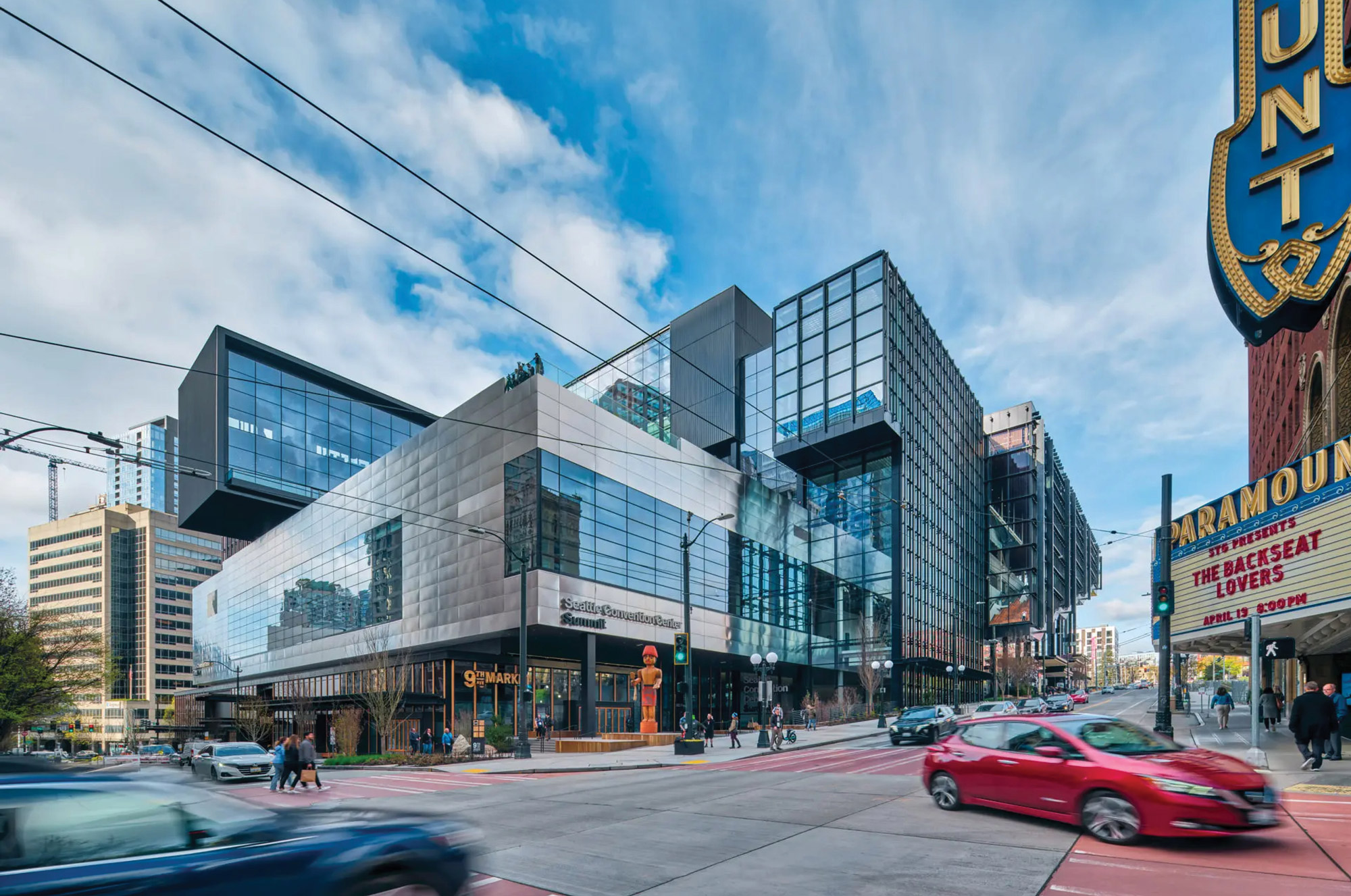
The Seattle Convention Center Summit Building uses silva cells, hanging planters, and captures rainwater for flushing toilets to reduce stormwater flows.
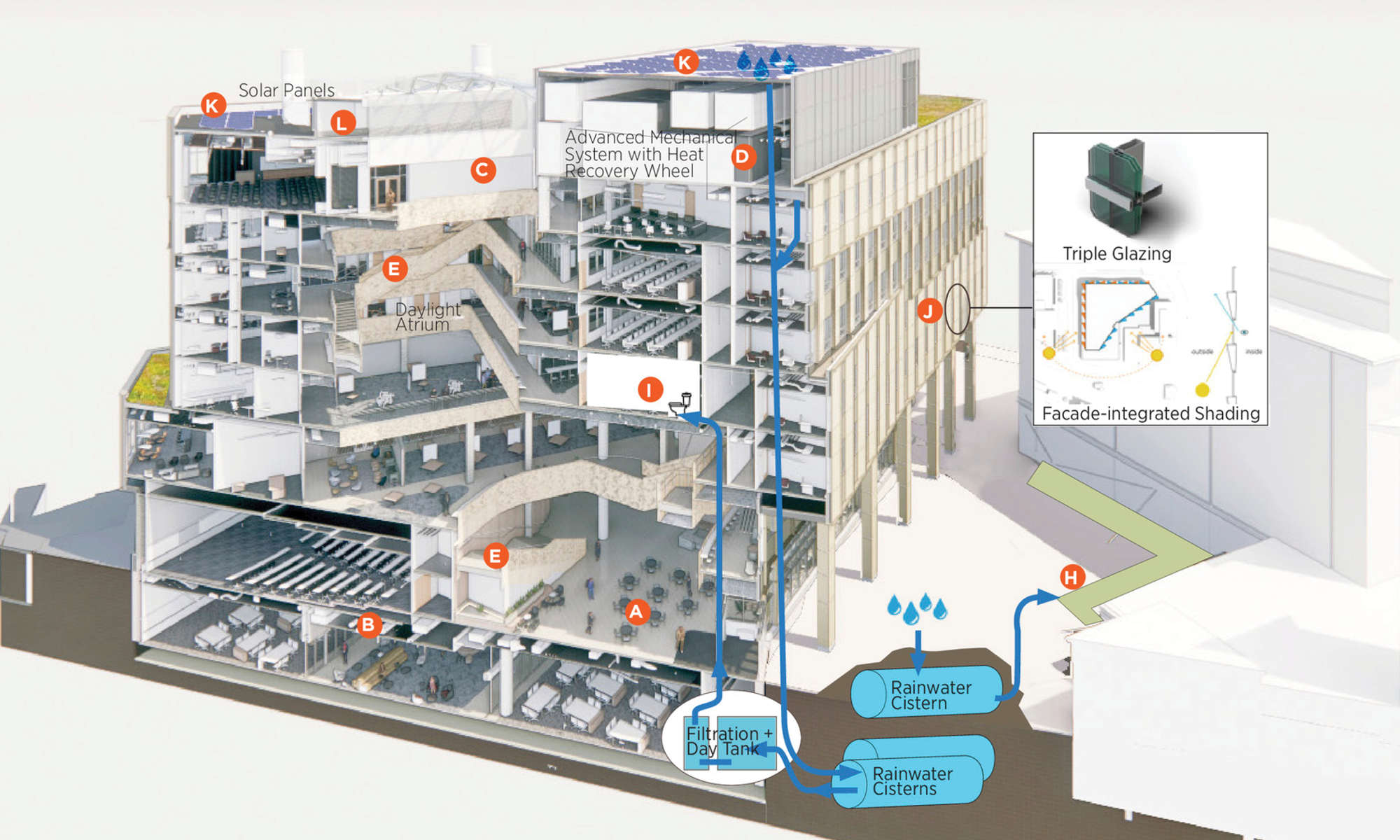
The University of Wisconsin - Madison Computer Data and Information Sciences includes renewable energy, green terraces, and rainwater capture for toilet flushing to reduce stormwater runoff.
Evaluation + Reporting
Did we achieve our design goals, including sustainable design goals? The prior sections outline practices to improve our outcomes, as well as metrics in areas where we can measure outcomes.
Firm Processes
- One-year check in with client after occupancy on every built project.
- Publish AIA 2030 Commitment data on energy use reduction and embodied carbon reductions.
- Assess carbon footprint every 2 years. Include office energy use, business travel, commutes, and other office-related CO2e. Explore industry-specific carbon accounting methods.
- Increase rigor of annual carbon offsets based on Path To Zero Carbon research.
- Explore 3rd party certification for carbon neutrality.
- Continue to track energy use on LMN’s several ILFI and LEED Zero Carbon/Energy projects.
Pilot Areas
- Select 1-2 projects each year for more thorough Post Occupancy Evaluation
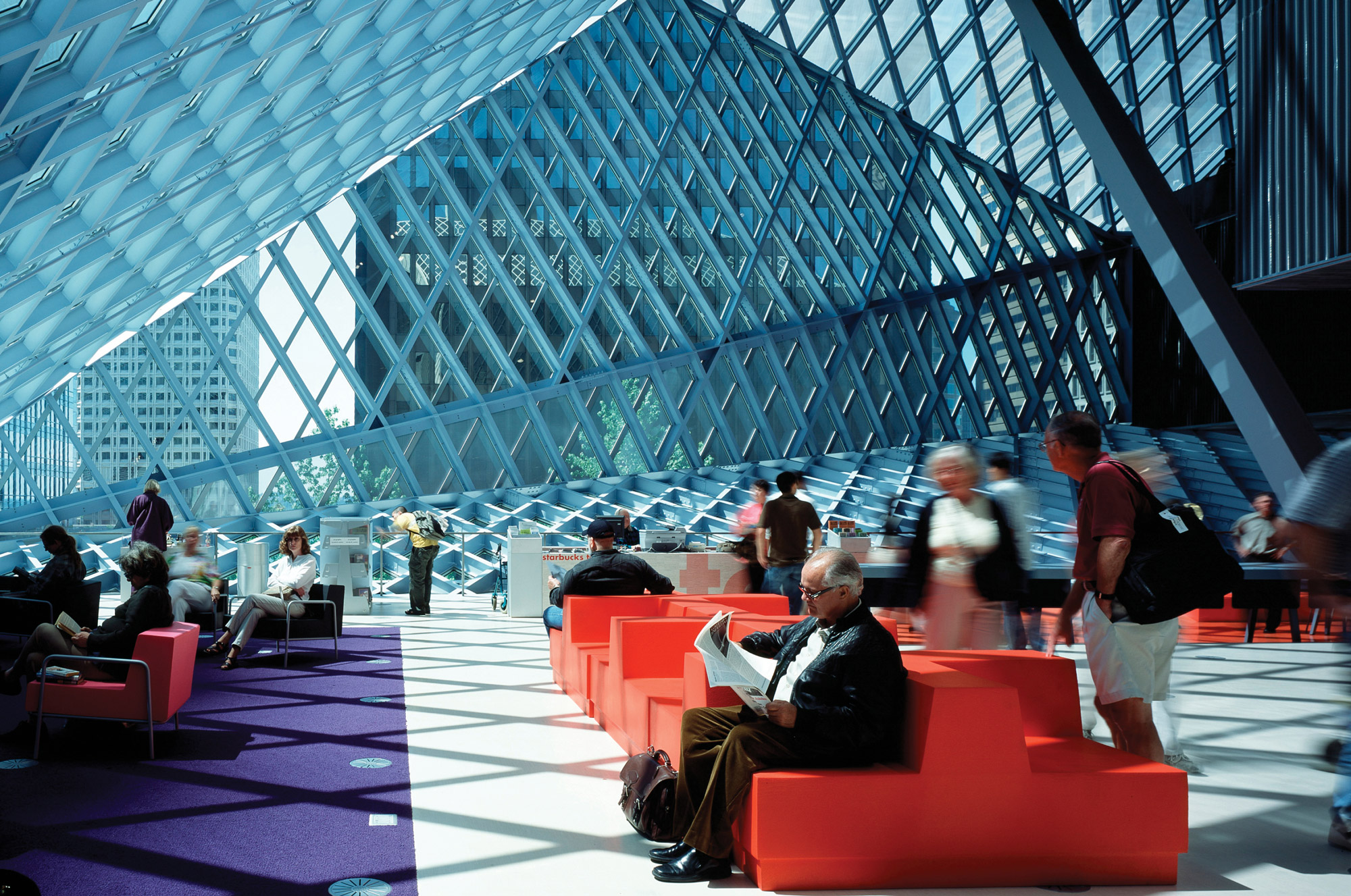
The Seattle Central Library, completed in 2003, has an EUI of around 38 kbtu/sf/year, much better than the energy model, and continues to use the rainwater capture and reuse system.
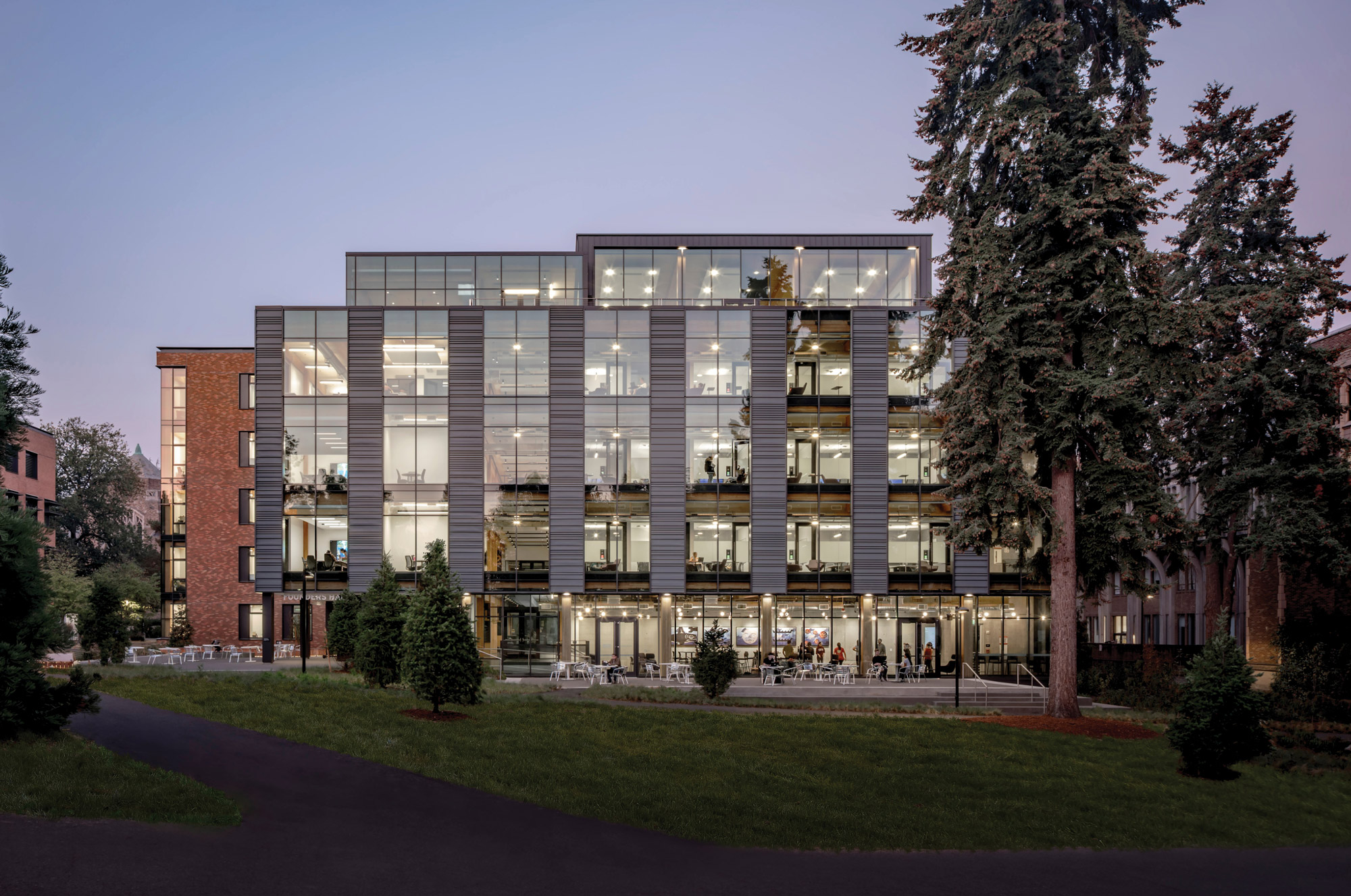
The University of Washington Founders Hall was designed to have an EUI around 24. After 15 months of tracking, the actual EUI is around 28 and trending downward.
Advocacy + Engagement
LMN’s work extends well beyond our projects – we help train the next generation, are active in policies at local, state and national scales, work with and support numerous non profits, and push boundaries with research and collaborations that advance architecture and design. For as much as we give, we learn and are inspired in return.
Firm Scale
- Sustainability on-boarding for new staff, including summary of commitments.
- LMN internal sustainability awards
- Intranet posts after sustainability conferences
- External speakers at Green Team meetings
- Vendors speaking at LMN required to meet LMN policies re: products and food
- Project Design Reviews include sustainability dashboard
- Internal sharing after sustainability conferences
- Vet public statements of sustainability goals and achievements to ensure rigor
Project Scale
- Identify consultant partners that drive us toward our sustainability goals, including active members of AIA 2030, MEP 2040, SE 2050, ASCE 2050, CLF, and other collaborative, leading organizations.
- Communicate LMN’s sustainability goals to potential partners.
- Target projects where clients align with LMN’s sustainability goals.
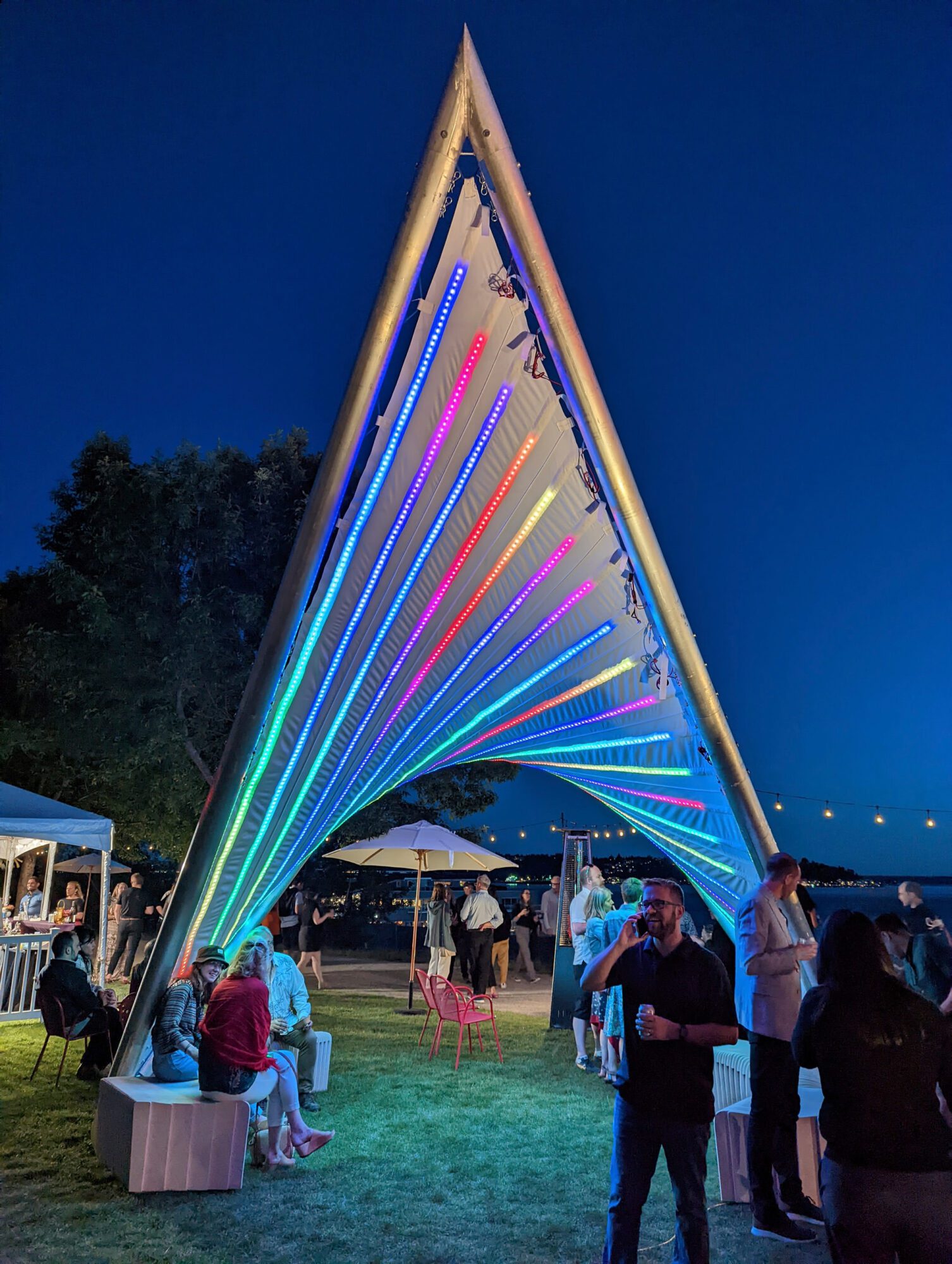
LMN has designed custom pavilions for each Seattle Design Festival since 2014.
Advocacy Engagement, 2024
- Washington State Building Code Councilmember, Energy Code Technical Advisory lead
- ILFI Energy + Carbon Technical Advisory Group member
- AIA Washington Council Climate group member
- Sponsor: Carbon Leadership Forum, United State Green Building Council, International Living Future Institute, ShiftZero, Seattle 2030 District, many more
- Started Carbon Leadership Forum Seattle Hub
- White House invited embodied carbon panelist
- Seattle Design Festival, festival installations each year since 2014
- Active in City and neighborhood design review boards
- Working with and supporting non profit partners such as Sawhorse Revolution and Architecture 2030.
- AIA National Committee on the Environment Advocacy Committee
- Published Path To Zero Carbon series and continue the public development of industry knowledge
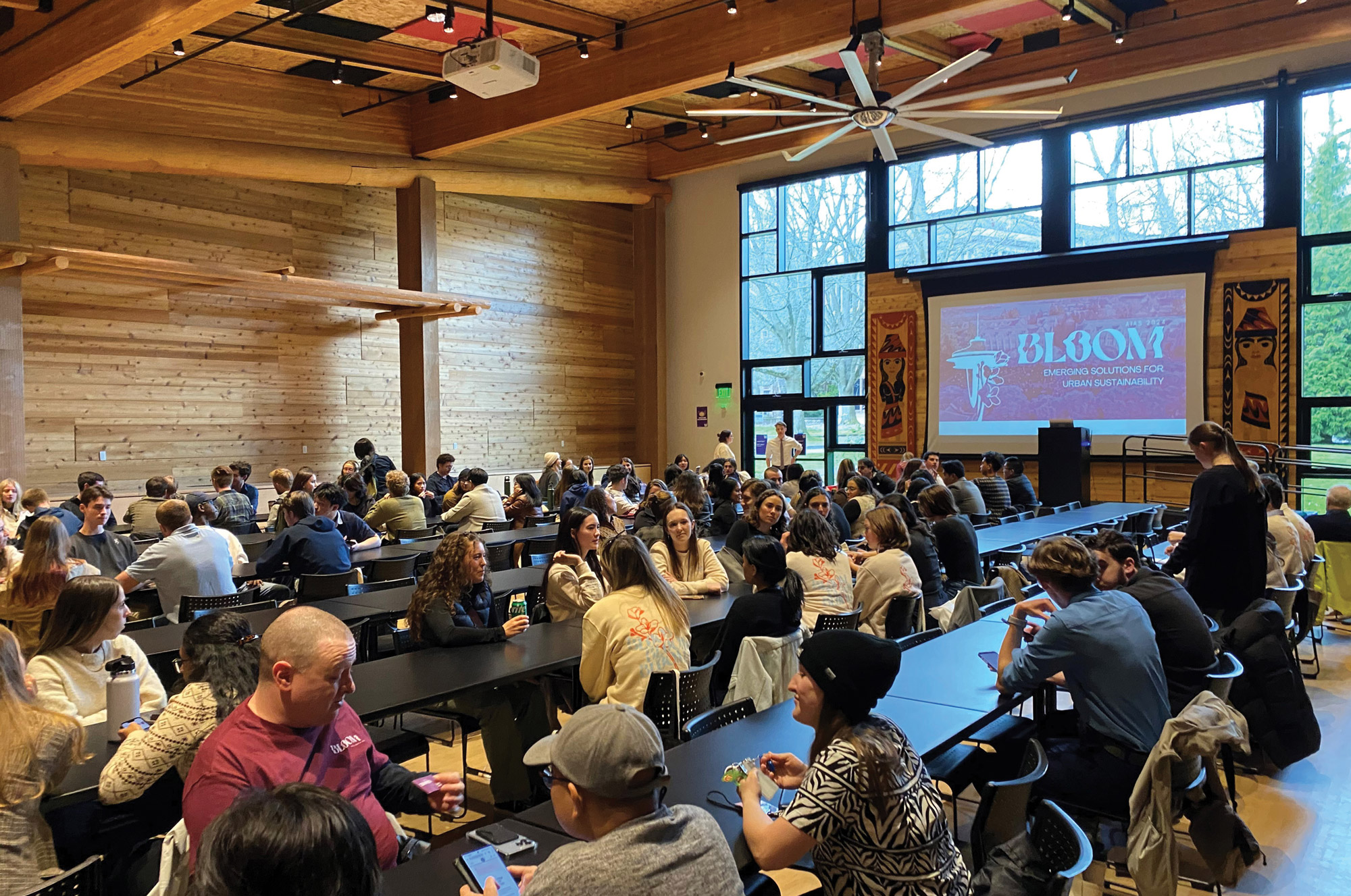
LMN supports conferences, such as the AIAS BLOOM conference, with panelists and keynotes to help put tools in the hands of the next generation of designers.
LMN Carbon Footprint
LMN buys carbon offsets equal to our annual carbon footprint. We understand that carbon offsets are not adequate to claim carbon neutrality, but they accomplish some climate action. Our primary focus is on our buildings operational and embodied carbon, as that is 2,400 times more impactful than our company’s internal Scope 1 and 2 emissions.
